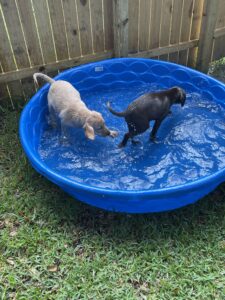Hey there, Labrador puppy parents! Picture this: Your adorable, fluffy buddy is happily wagging its tail one minute, and the next, something's not right. Maybe they ate something they shouldn't have, or they're suddenly limping. Scary, right? But don't worry! Like superheroes have toolkits, you can be prepared to tackle any health emergency your furry friend might face. Let’s dive into how you can be the hero your Labrador puppy needs.
Puppy 911: Recognizing a Pet Emergency.

First things first: knowing when your pup is in trouble is crucial. Some red flags include excessive vomiting, trouble breathing, or if they’re just not acting like their usual playful selves. Maybe they're whining more than usual or refusing to eat. These signs can be the puppy version of shouting, "Hey, I need help!"
Also, please be on the lookout for less obvious signs. Limping or reluctance to move can indicate pain or injury. Check for swelling or heat, especially after a rough play session. Also, keep an eye on their bathroom habits. Changes in their waste's frequency, color, or consistency can signal health issues. Don't ignore excessive drooling or changes in their gums' color, as these can be signs of toxicity or other severe conditions. Please also pay attention to their eyes; redness or discharge could mean an infection. Remember, you know your Labrador puppy best. Any sudden changes in their behavior or physical condition could warrant a quick response. By being observant and proactive, you can catch potential emergencies early and ensure your furry friend gets the care they need immediately.
Canine First Aid: Immediate Steps to Help Your Pup
Quick thinking can make all the difference if your pup is in trouble. Let’s say they’ve gobbled up something harmful. The first step? Call your vet or an emergency pet hotline. They can guide you on whether you need to induce vomiting or rush to the clinic. In case of cuts or wounds, gently clean the area and apply pressure to stop bleeding. Remember, keeping a pet-specific first aid kit can be a lifesaver.
In addition to these actions, there are other crucial steps in canine first aid. If your puppy seems to be choking, you may need to perform a modified Heimlich maneuver suitable for dogs. However, this should only be tried if you're familiar with the technique; otherwise, you risk causing injury. Cool the affected area with running water and cover it with a moist cloth for burns or scalds. In case of heatstroke, common in Labradors, immediately move your pup to a more relaxed area and offer small amounts of water.
Avoid giving any medication without consulting a vet, as some human medicines can be toxic to dogs. If your puppy is in shock, characterized by a weak pulse and shallow breathing, keep them warm and quiet while you seek immediate veterinary attention. Remember, your swift and informed actions can significantly impact the outcome of any emergency involving your beloved pet.
Stay Calm, Puppy Parent: Managing Stress in Emergencies.

Panicking can make your pup more anxious, and trust me, that’s not helping anyone. Take a deep breath. Your calm demeanor can reassure your pet that they’re in safe paws. Talk to them in a soothing voice and move gently. Being a calm, collected puppy parent helps you think clearer and act more effectively.
Establishing a routine that keeps you prepared and confident is also helpful. You can regularly practice what you would do with your puppy in various emergencies. This helps you stay calm when an actual emergency occurs and gets your pup used to being handled in different ways, which can be crucial in stressful situations.
Please remember to keep a positive attitude. Dogs, especially intelligent breeds like Labradors, are susceptible to their owner's emotions. They'll pick up on it and become stressed if you're stressed. In an emergency, speaking in a calm, reassuring tone can help keep your puppy settled. Also, after the emergency, could you take time to de-stress yourself? Please reflect on the incident, learn from it, and don't be hard on yourself. Emergencies can happen to anyone; the best we can do is learn and prepare for the future.
Your Puppy's Safety Kit: Essential Items to Have
Just like you’d have a first aid kit for humans, having one for your puppy is super important. Stock it with gauze, non-stick bandages, antiseptic wipes, and a thermometer (and no, not the one you use!). Include the phone number of your vet and the nearest animal hospital. It’s also wise to have a list of common toxic substances handy, like certain foods and plants that are a big no-no for dogs.
In addition to these items, your puppy's safety kit should also include a pair of tweezers for removing splinters or ticks, a muzzle (even the gentlest dog might bite when in pain), and a blanket for keeping them warm or moving them if they can't walk. Saline solution can help clean out their eyes or wounds. It’s a good idea to have a syringe or dropper to give oral treatments or water if needed.
Remember to include an emergency stash of your puppy's food, some fresh water, and a portable bowl, especially if you're traveling. Keep a spare supply in the kit if your puppy is on any medication. Lastly, consider adding a pet first aid manual – it can be a great reference in a pinch. Regularly check and update the kit to ensure everything is in working order and within expiry dates. This way, you’ll always be ready for any unexpected situation with your furry friend.
Post-Emergency Care: Ensuring Your Pup’s Quick Recovery
After handling the immediate danger, ensure your pup gets plenty of rest. Follow your vet's advice on care and medication. Monitor them for any changes or signs they’re not recovering as expected. And, of course, give them lots of love and gentle cuddles – emotional support is key in recovery!
Post-emergency, creating a calm and comfortable environment for your puppy is essential. If recovering from an injury, ensure their resting area is easily accessible and free of obstacles. Soft bedding can provide extra comfort for a recovering pup. Depending on the emergency, your vet might recommend a special diet or limited activity. Stick to these guidelines closely to ensure a smooth recovery.
I think monitoring your puppy's behavior and physical condition in the days following an emergency is crucial. Please look for signs of distress, discomfort, or a relapse of symptoms. Don't hesitate to contact your vet if you're concerned about their recovery process. Remember, recovery can be as much an emotional process as a physical one for you and your puppy. Be patient and give them the time to return to their playful, energetic selves. Your care and attention during this period are invaluable to their healing.
So there you have it, brave puppy parents. With these tips, you can be prepared to face any health emergencies that come your pup’s way. Remember, Labrador puppies rely on you to keep them safe and healthy. By being prepared, you're not just a pet owner but a pet hero! 🐾🦸♂️🚑
Date: 1/24